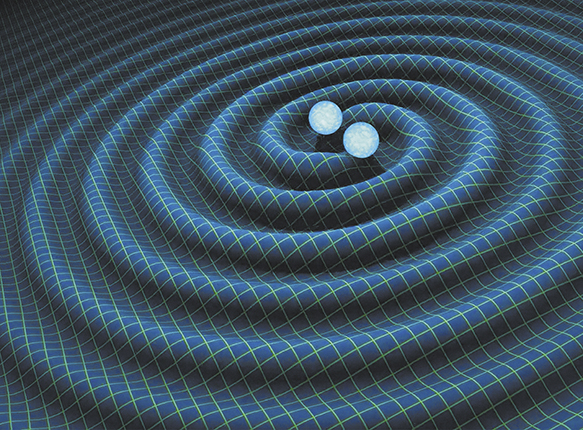A hefty textbook for an ever-changing discipline
DOI: 10.1063/PT.3.4046
Kip Thorne and Roger Blandford’s new textbook, Modern Classical Physics: Optics, Fluids, Plasmas, Elasticity, Relativity, and Statistical Physics, is a tour through macroscopic physics that features modern treatments of classical topics and insightful treatments of modern ones. If you are looking for a classical mechanics book whose subject matter ranges from nonlinear optics to the difficulties of controlled fusion and the detection of gravitational waves, this is the book for you.

Artist’s impression of binary neutron stars generating gravitational waves.
ROBERT HURT/CALTECH-JPL

Explaining their rationale and emphasis, the authors write that although the 20th century was largely the century of quantum mechanics, “classical physics has not stood still while the quantum world was being explored. In scope and in practice, it has exploded on many fronts and would now be quite unrecognizable to a Helmholtz, a Rayleigh, or a Gibbs. In this book we have tried to emphasize these contemporary developments and applications at the expense of historical choices, and this is the reason for our seemingly oxymoronic title, Modern Classical Physics.”

At 1500 oversized pages, Modern Classical Physics exceeds in length (by about 20%) even the prior opus of one of the authors, the textbook Gravitation (1st ed., 1973), an introduction to general relativity that Thorne wrote with Charles W. Misner and John A. Wheeler. The present work is more straightforward in tone and approach, though in spots you’ll see an attenuated version of the flair and exuberance for which Gravitation is known.
The presentation in Modern Classical Physics demands that readers have considerable prior knowledge. As acknowledged in the preface, they are presumed to have an undergraduate-level command of classical mechanics, electromagnetism, thermodynamics, and applied mathematics. After a rather sophisticated introductory section describing Newtonian kinematics and special relativity, the book moves on to six sections that survey the six areas of physics enumerated in the subtitle.
Readers can learn a lot here, though in places they will have to work hard for the lessons. The breadth of topics challenges what can be fully explained even in 1500 pages, and although many of the explanations are detailed and useful, some are less thorough. Given the scope of the work, though, it seems pointless to quibble over omissions or rare points of disagreement.
As the authors explain in the acknowledgments, the book developed from graduate courses they taught over decades, mostly at Caltech. Their students must have learned a great deal. Certainly graduate students in physics typically do not get such a thorough grounding in most of the topics treated by Thorne and Blandford. A faculty member could plan a graduate course based on selected parts of the book, though it would take several courses to cover the entire text.
Given world enough and time, most of us would do well to put everything else aside for a couple of months, study Modern Classical Physics systematically, and come back with our knowledge well refreshed. Short of that, we could satisfy our curiosity—or possibly pique it further—on many topics. And certainly, many of us would appreciate this book as a reference. On the whole, Modern Classical Physics is a magnificent achievement.
More about the Authors
Edward Witten is the Charles Simonyi Professor of mathematical physics at the Institute for Advanced Study in Princeton, New Jersey. In 1990 he was awarded the Fields Medal from the International Mathematical Union for his work on supersymmetry, low-dimensional topology, and the positive energy theorem in general relativity.
Edward Witten. Institute for Advanced Study, Princeton, New Jersey.
